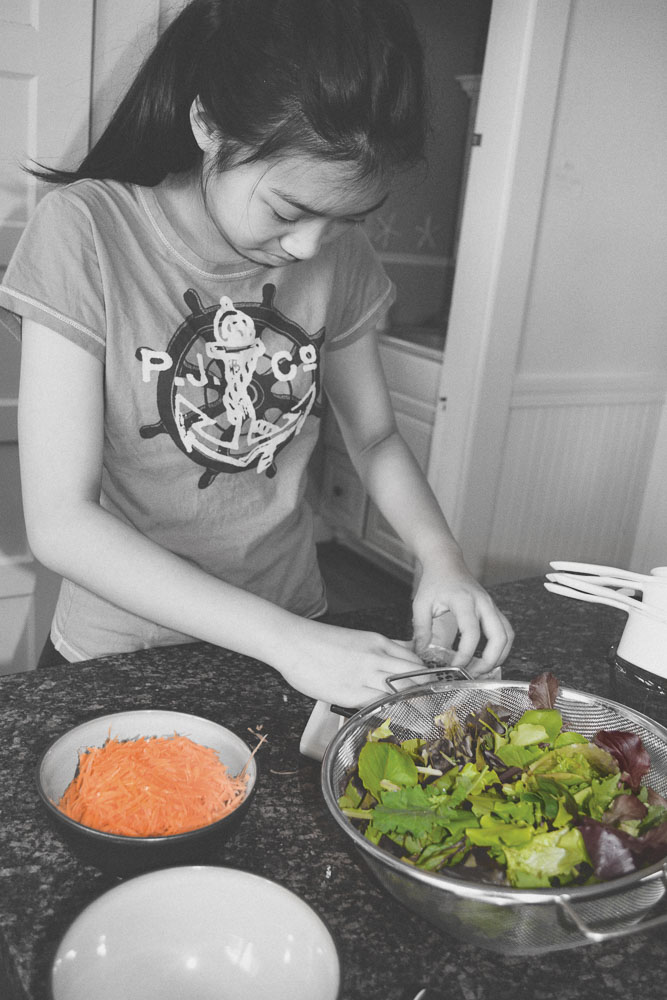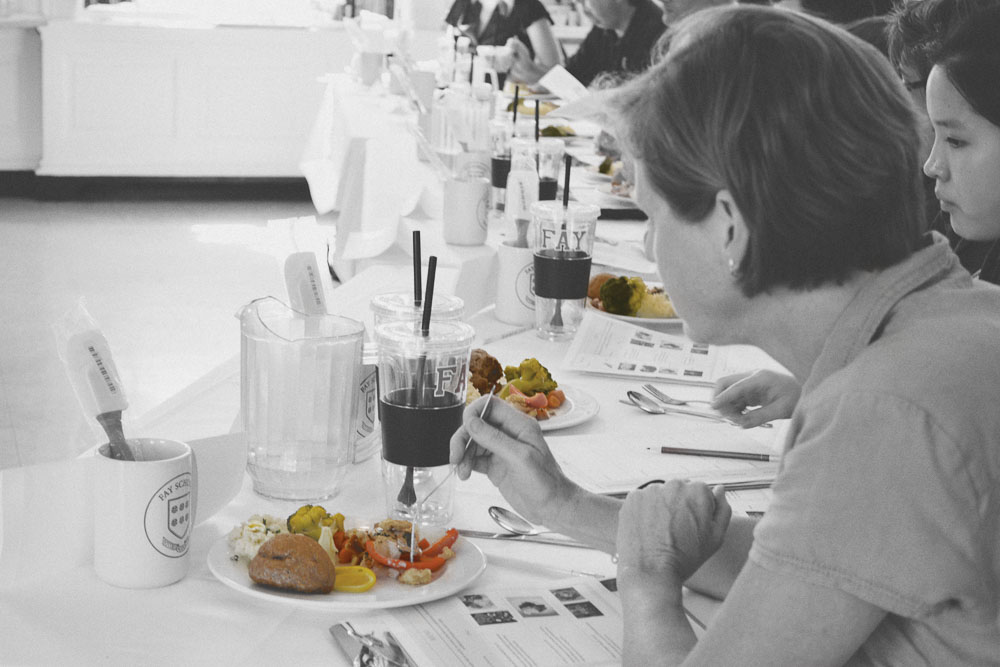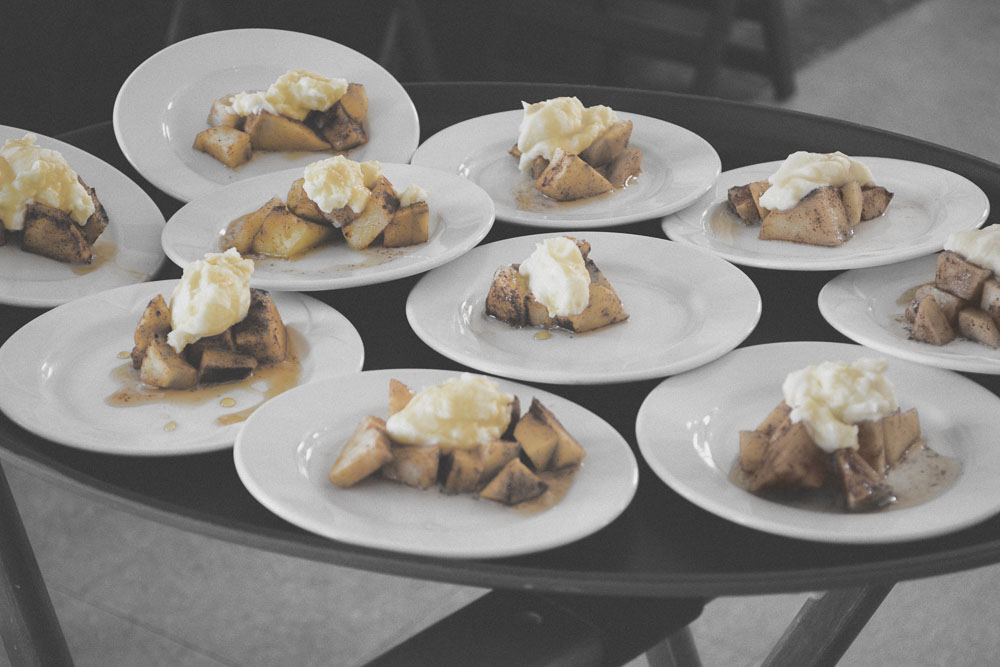Diagnosing the Modern World
Photos by Tara Taft
“We’re going to think about food today,” Tim McCauley said to the 20 students sitting in a classroom circle last November. “Think about food you crave when you go home. Is there a food you associate with home?”
One by one, the ninth graders raised their hands, slow at first to respond, then eager to share their favorite foods from back home in Thailand, Japan, Mexico, Nigeria or just down the street in Southborough. The students’ answers included everything from chopped cheese and honey buns to sticky rice, conch salad, strawberry ice cream, steamed egg, green vegetables, donuts, Lebanese food, white rice grown by one student’s grandpa and Spanish food cooked by another’s grandma.
Food is one of three topics covered in this ongoing social science class at the Fay School, a private school located in Southborough, Massachusetts. Called “Diagnosing the Modern World,” the class is co-taught by Tim McCauley, a science teacher, and his wife, Emily McCauley, a history teacher, and includes sections on water, energy and food. According to Tim, the goal is to give students the skills to understand contemporary topics and to encourage them to examine their own roles as global citizens. The teens, many of whom are boarding students, come from the U.S. and around the world.
As last year’s course neared its end in May 2016, these students were challenged to create menus and prepare food for a cooking competition. Food like locally caught baked haddock encrusted with fresh herbs, honey-coated apples and freshly whipped local cream, vegetable tacos and fish tacos, key lime pie, jicama slaw, Brazilian steak, rice and beans, and bacon macaroni and cheese. They were judged by local food industry professionals on taste and presentation, as well as sustainability, nutrition and cost. I was a judge for a previous year’s class, and then got to drop in periodically with the 2015–16 group, visiting the classroom and learning what the students learned as they prepared for their own springtime cooking competition.
When I first visited the class, back in the fall of 2015, the students were learning about the properties of water and individual water rights. The next time I visited, in March, they had finished their segment on energy—from natural resources to the energy we need to fuel our bodies—and were ready to start talking about food.
“What foods make you happy?” Tim asked. This time, the answers came quickly and easily with smiles and laughs: ice cream and bacon, barbecued pulled pork, pizza, garlic, brownie batter, pretzels with double queso, Buffalo wings, oxtail, shrimp sushi, honey-roasted pretzels, mangos and sticky rice, omelets and burgers.
This year is the sixth rendition of the class, and the Mc- Cauleys are continually tweaking it. With Michael Pollan’s The Omnivore’s Dilemma as a textbook for the food section, the students learn and think about concepts relating to food. They learn about food nutrition, production, availability, regulation, affordability and sustainability. They learn how to read labels and ponder questions about the American food system and culture. They watch the movie Fed Up, a documentary focusing on the American food industry’s role in the obesity epidemic, and they go on field trips to a supermarket and a local farm.
* * *
When I visited the class again in late April, around the room were eight posters, each with a question contrasting organic, local, industrial, seasonal or economic options. Tim grinned and his eyes sparkled. “We’re going to play ‘Pick Your Poison,’” he said to the class. The students and I moved from one side of the room to another as we answered questions like: “Would you rather have strawberries available to eat only two months a year, because that is their growing season in New England, or available year round but shipped in from Mexico?” and “Would you rather eat store-bought organic tomatoes or tomatoes grown in your own backyard?” The questions were designed to make us think, and they did. Because there are a lot of things to consider when buying food at the supermarket, Tim said to the students, “Hopefully, we’re making it easier for you to make choices.”
In early May we visited a supermarket. Divided into teams, the students examined food labels searching for the cheapest, the most local, the healthiest and the most responsible/ethical items to serve to a hypothetical family of four. The following week, we visited Chestnut Hill Farm, a Trustees of Reservations property located in Southborough, where the students saw the farm’s fields and greenhouse and learned about crop rotation and the life of a farmer.
With less than two weeks until the cooking competition, it was now time to learn about food cleanliness, safety and presentation. “We want to be sure you’re knowledgeable, so you can be safe,” Tim said. “It’s very easy to forget where your fingers are.” No student had ever cut themselves, and he hoped to keep it that way.
Tim showed the students how to zest an orange, and how to peel and chop potatoes and tomatoes safely. With a few cuts here and there, Emily created a cucumber boat. Tim peeled the skin of a tomato to create a rose, and when he carved zigzags in an orange and pulled it apart, the teens cheered. The cooking teams practiced using a chef’s knife and a paring fruit they had never tried (Asian pear and star fruit). “Think about colors, textures, shapes; the more variety you have, the better it looks to the judges,” Tim said. “If we perceive things as better, they taste better.”
* * *
Then came May 31, 2016, a beautiful spring day and the morning of the cooking competition. With bags and milk crates full of meat and produce purchased on a field trip to the Boston Public Market and a local supermarket, the students gathered in Tim and Emily’s home on campus for some last-minute instruction. Two teams would be sharing Tim and Emily’s kitchen; the other students were assigned to one of five other kitchens on campus. They would be racing the clock: prepping, cooking and preparing informational materials for their team’s presentation to the judges. A few dishes had been made ahead of time (dinner rolls, key lime pie, chicken broth), but most of the food would be made today. It was now a little after 10 in the morning, and judging would begin at about 2pm.
Two years ago, the McCauleys had added a new component to the competition: a secret ingredient which must be seen somewhere in the meal. Last year’s secret ingredient was rainbow chard, and the year before it was kale. For 2016, Tim held up a red pepper. The students shouted and laughed; each team added two peppers to its own bag of groceries and they headed off to their respective kitchens to begin cooking. Although red pepper was not currently in season, Tim later told the judges, “We didn’t want to give them something that would throw them for a loop but something that would make them be a little more creative in the moment.”
A CrockPot bubbled with pork on the kitchen counter while Gabe and Kabelo cut up jicama, red pepper and carrots to make a slaw. Buns and butter seemed unhealthy, they tell me, so they would be wrapping their pulled pork in lettuce leaves instead. As Jose grated an eggplant, he told me about the vegetable tacos he and his teammates Alex and Eduardo were making in addition to Brazilian steak, rice and beans. The recipe was from Jose’s Brazilian grandmother, who replaced meat with eggplant when she became sick. “One day I went to her house, and I tried these tacos, and I didn’t know it wasn’t meat,” he said.
In another kitchen down the road, Caroline and Claire were creating sweet-and-sour chicken and cutting up vegetables while Miné flipped green tea mini pancakes. Miné said she had been experimenting while creating the pancakes, adding a little less matcha powder and a little more sugar to get the right balance and taste.
Thomas, Louis and Robby were preparing herb-encrusted baked haddock. The herbs were fresh, the haddock was locally caught and the breadcrumbs were made from rolls they made the day before. As he mashed potatoes and added butter and garlic, Robby told me that at home making mashed potatoes is his job every year at Thanksgiving.
Tori was making tortillas from scratch, using a heavy package of brightly colored construction paper to press and flatten balls of masa dough into circles before frying them into tortillas. Samantha (Sam) was cutting up fish while Andrew blended a marinade of achiote paste, orange juice, vinegar, onion and garlic. Sam, whose mom taught them how to make the sauce, later told the judges, “We put a little bit of lime in the tacos; it gave it the powerful taste that we wanted to have.”
After debating whether to steam or broil the red peppers, Lin, Yui and Michelle decided to use them as bowls to contain the steamed shrimp and rice noodles they were preparing. They were busy chopping chicken and slicing vegetables while making chicken and mushroom soup and a mixed green salad. Their goal was to create a simple and fresh meal using natural and colorful ingredients.
It was now about 1:30pm and a few teams were almost ready; the others were still scrambling. The judges—nine guests from a variety of food-related professions plus one student—had arrived. Tim greeted and instructed the judges, describing the event. While the assignment had been to create just one dish, each team had come up with its own menu, many adding a side or a dessert. One at a time, each team would present its food to the judges, who would evaluate the dishes according to sustainability, nutrition, economics, appearance and taste. According to Tim, each team should be able to speak knowledgeably about the food they had prepared. “They should be able to tell you how much that meal cost for a family of four, or scaled for the whole Upper School to eat,” he said. Each judge had a scorecard, which Tim said would not be shared directly with the students.
“What I would love from you guys is to make them squirm,” Tim said. “Ask them tough questions. I told them that there’s no better moment for me than when I’m sitting in the back and they get a question that they don’t know how to answer because this is the best time for them to learn how to do this.”
A few minutes later, the judges were sitting at a long table in the dining hall, each with a clipboard, pen and glass of water, waiting to eat. Behind the double doors, the teams gathered in the cafeteria’s industrial kitchen in order of readiness, hurriedly plating their dishes on 10 different plates, spooning and ladling, adding a few berries, a stick of cinnamon, a sprinkle of lime zest, a sprig of rosemary. One at a time, each team served the judges then presented the recipes’ origins, their ingredients and the economics behind each dish.
The judges tasted and listened. They asked the students to define the word local (answer: New England) and questioned each team’s source of ingredients, from vegetables and garlic to chicken and cheese. When Gabe said it was difficult to find the Mexican-grown jicama for his slaw, judge Desiree DuBois of Chestnut Hill Farm suggested a more local alternative would have been kohlrabi. When Brendan protested that the supermarket’s sign above the broccoli he used said it was local, judge Kim Denney of Chestnut Farms told him that broccoli wasn’t in season yet, so it must be from California.
“You have to really work hard to find out what’s behind the label,” she said, emphasizing the importance of knowing your farmer, your community and your growing season. When the judges questioned one team’s use of “local” Parmesan cheese, the students discovered that though bought locally, it couldn’t have been made locally. “To be true Parmigiano Reggiano, it has to be made in Italy,” judge Sarah Blackburn of Edible Boston told them.
“We used fruits and vegetables that were in season right now,” Caroline told the judges as they ate her team’s arugula salad, grilled asparagus and red pepper, sweet and sour chicken and green tea pancakes with strawberries and whipped cream. Ink said she chose to make Thai spring rolls with peanut sauce, “Because it’s one of the traditional Thai dishes my mom likes to make and also because it contains a variety of vegetables in all kinds of colors, which was one of our food goals.” Ink’s teammate, Brendan, wanted to incorporate his favorite food into the Thai theme, choosing to stir-fry chicken with mango, even though it wasn’t grown locally. Maya chose to make arroz con leche, a Hispanic dish traditional to her own heritage. “It’s a dish I grew up learning how to make, and I was surrounded by this culture,” she said. Brendan told the judges, “You have to find a balance: Are we going to find local organic foods or find cheaper foods that have to be imported that are not organic?” He paused. “For me it came down to, ‘If I had a child, would I feed it to my child?’”
It was after 4pm, and each judge had sampled dishes from all seven teams. The judges thanked the students for sharing their family recipes but expressed their wish that more local products had been used in the cooking competition, while acknowledging that even in late May there isn’t a lot of local produce to be found. The judges completed their scorecards and gave them to Tim, who would later share the results with the class.
In teaching this course, Tim said, he isn’t trying to tell the students what to buy or what to eat but to help them make informed decisions about food. As he told the judges, “We’ve been talking a lot about where food comes from—everything from backyard gardens to big industrial farming; everything from subsidies all the way down to CSAs. We’ve tried to expose them to a ton of different things. Then we give them this project to see where their decision making is. Then we bring in you guys to see how they are at defending their decisions.” Many students said that learning about nutrition, labeling and how to find out where their food comes from were the most important lessons they learned.
According to one student, “I learned that it is not always easy to make the healthiest and most local food, and we should do what we can with what we have.”
“PICK YOUR POISON”
Would you rather eat certifi ed organic apples from the most pristine and perfect orchard in Washington or non-organic apples grown less than 20 miles away at a responsible and community-oriented orchard?
Would you rather have strawberries available to eat only two months a year, because that is their growing season in New England, or available year round but shipped in from Mexico?
Would you rather buy USDA certifi ed steak from your local supermarket or steak from your local farm that had their cow processed and is certifi ed to sell it?
Would you rather eat a burrito from a local shop that says they use only the best ingredients for approximately $6 or a burrito painstakingly made in your own kitchen with ingredients you picked out from your most trusted local supermarket for approximately $12?
Would you rather eat pure cane sugar or allnatural stevia?
Would you rather eat chocolate from a chocolate maker that buys direct from a Haitian plantation (direct trade) and produces the chocolate locally or from a chocolate maker that is the oldest in America and produces in Pennsylvania?
Would you rather eat store-bought organic tomatoes or tomatoes grown in your own backyard?
Would you rather eat golden rice: a product that is fortifi ed with vitamin A and capable of helping end world hunger (which means it’s a GMO) or organically grown white rice?
THE JUDGES
Daniele Balian Tomasso Trattoria
Sarah Blackburn Edible Boston
Heidi Broadley ChopChop Magazine
Cynthia Conigliaro Certifi ed Holistic Health Coach
Kim Denney Chestnut Farms
Erica Nam Fay Student Judge
Desiree Robertson Dubois Chestnut Hill Farm
Rick Leblan Massachusetts Department of Agricultural Resources
Tony Penezic Sage Dining Director
Julie Porrazzo Fay School Director of the Educational Program





